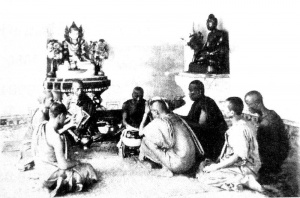Upasampada
[[Upasampadā] (Pali) literally means "approaching or nearing the ascetic tradition." In more common parlance it specifically refers to the rite of ordination by which one undertakes the Buddhist monastic life.[1]
According to Buddhist monastic codes (Vinaya), a person must be 20 years old in order to become a monk or nun. A person under the age of 20 years cannot undertake upasampada (i.e., become a monk (bhikkhu) or nun (bhikkhuni)), but can become a novice (m. samanera, f. samaneri). (To see how a person sets out to gain upasampada, see pabbajja or "adopting the condition of mendicancy.") After a year or at the age of 20, a novice will be considered for the upasampada.[2]
Certain organizations may require a person to practice in a semi-renounced state for a set period of time for the sake of preparation and cultural familiarization.
The strictures surrounding upasampada are different for samaneras and samaneris.
Traditionally, the upasampada ritual is performed within a well demarcated and consecrated area called sima (sima malaka) and needs to be attended by a specified number of monks - "ten or even five in a remoter area" (Peter Skilling, How Buddhism invented Asia, 2009).[3]
Footnotes
- ↑ Rhys Davids & Stede (1921-25), p. 147, article on "Upasampadā" (retrieved 26 Sep 2007 at http://dsal.uchicago.edu/cgi-bin/philologic/getobject.pl?c.0:1:3930.pali).
- ↑ Encyclopædia Britannica (2007).
- ↑ Peter Skilling, How Buddhism invented Asia, 2 April 2009. Peter Skilling interviewed by Phillip Adams. Online audio recording.
